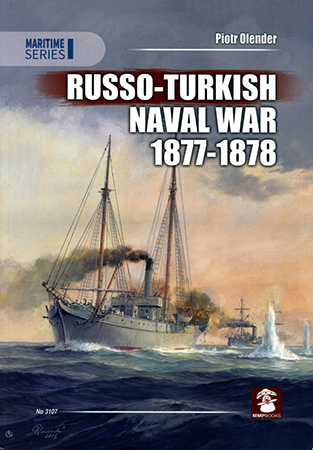
Russo-Turkish Naval War 1877-1878 Book Review
By David L. Veres
| Date of Review | December 2017 | Title | Russo-Turkish Naval War 1877-1878 |
|---|---|---|---|
| Author | Piotr Olender | Publisher | Mushroom Model Publications |
| Published | 2016 | ISBN | 9788363678456 |
| Format | 224 pages, hardbound | MSRP (BP) | $49.00 |
Review
Piotr Olender illumines origins of modern Balkan and Turkish conflicts in MMP's lavishly illustrated Russo-Turkish Naval War 1877-1878 – available in North America from Casemate.
Twenty years before, the Crimean War virtually destroyed Imperial Russia's Black Sea Fleet. And the 1856 Treaty of Paris ending hostilities demilitarized the Black Sea itself.
That forced Russia to employ a "motley collection" of smaller remaining warships and armed merchant vessels "without great combat value". Its vestigial Black Sea Fleet and Danube units – reinforced by Romania's small navy – bore the brunt of combat against Ottoman forces.
Turkey, by contrast, boasted more plentiful and powerful naval assets – including 15 ironclad battleships, six frigates, 13 corvettes, 15 gunboats and dozens more smaller vessels in two, geographically proximate Ottoman fleets and its Danube flotilla.
Contents cover:
- Combat Operations on the Danube
- Combat Operations in the Black Sea
- End of War Outcomes
Riverine actions proved pivotal to Russia's successful European land campaign. And Olender's accounts of Russian mine-laying exploits and spar-torpedo attacks on Turkish Danubian vessels certainly underscored that.
Major maritime operations centered on the Black Sea theater. There, several Ottoman navy attempts to instigate local Muslim uprisings failed. And Turkish naval assets remained relatively passive in the conflict.
With "no conventional warships on the Black Sea", Russia, by contrast, employed civilian vessels as makeshift "active defense steamers" armed, surprisingly, with 6-in mortars. Imperial boats with Whiteheads also sunk the Turkish gunboat Intibah in Jan 1878 – history's earliest such success.
Far from exclusively examining naval actions, MMP's narrative also devotes considerable coverage to land campaigns in both Europe and the Caucasus.
Photos, annotations, maps, charts, tables, and index season MMP's superb study. Three appendices recap fleet inventories, naval artillery, and Russian mines. And a fourth features starboard drawings of 32 Russian and Ottoman warships.
But as with Olender's previous titles, maps proved problematic. Details are often confusing. And with mostly local views, readers face difficulties putting actions into broader geographic perspectives.
Finally, MMP's concluding warship drawings sport no scale references. So without a selected bibliography to aid further research, their value – especially to modelers – remains restricted.
Concerns aside, this is still an excellent, informative effort. For English-speaking enthusiasts, few have so effectively illumined the lasting impact of 19th Century naval operations as Piotr Olender has.
To wit: Imperial Russia's victory effectively ended the centuries-long Ottoman-Muslim domination of Christian southeast Europe. But it also kindled consequences.
Still-smoldering ethnic and nationalist ambitions sparked the 1912-1913 Balkan wars – and, eventually, a momentous, June 1914 murder in Sarajevo. The "powder keg of Europe" ignited humanity's first modern global conflict.
"And the rest", as they say, "is history".
Roundly recommended!
With thanks to Casemate for the review copy.







